Caballero B. (ed.) Encyclopaedia of Food Science, Food Technology and Nutrition. Ten-Volume Set
Подождите немного. Документ загружается.


See also: Antioxidants: Natural Antioxidants; Ascorbic
Acid: Properties and Determination; Physiology; Chilled
Storage: Principles; Dietary Fiber: Properties and
Sources; Enzymes: Functions and Characteristics; Folic
Acid: Properties and Determination; Physiology;
Potassium: Physiology; Spoilage: Chemical and
Enzymatic Spoilage; Bacterial Spoilage; Yeasts in
Spoilage; Storage Stability: Mechanisms of Degradation;
Parameters Affecting Storage Stability; Parameters
Affecting Storage Stability
Further Reading
Fellers PJ (1985) Citrus: sensory quality as related to root-
stock, cultivar, maturity and season. In: Pattee H (ed.)
Evaluation of Quality of Fruits and Vegetables, pp.
83–128.Westport, Connecticut: AVI Publishing.
Fellers PJ (1993) Citrus fruits: oranges. In: Macrae R,
Robinson RK and Sadler MJ (eds) Encyclopaedia of
Food Science, Food Technology and Nutrition, vol. 2.
London: Academic Press.
Food and Agriculture Organization of the United Nations
(2000) Citrus Fruit: Fresh and Processed. Annual
Statistics.
Food and Drug Administration (2001) 21 CFR Part 120:
Hazard analysis and critical control point (HACCP);
procedures for the safe and sanitary processing and
importing of juice; final rule. Federal Register 66:
6138–6202.
Kefford JF and Chandler BV (1970) The Chemical Con-
stituents of Citrus Fruits. New York: Academic Press.
Nagy S (1980) Vitamin C contents of citrus fruit and their
products: a review. Journal of Agriculture and Food
Chemistry 28: 8–18.
Nagy S and Attaway JA (eds) (1980) Citrus Nutrition and
Quality. Washington, DC: American Chemical Society.
Nagy S, Shaw PE and Veldhuis MK (eds) (1977) Citrus
Science and Technology, vols I and II. Westport, Con-
necticut: AVI Publishing.
Pao S, Petracek PD and Ismail MA (1997) Advances in
preparing peeled fresh-cut citrus. Food Technology
International 39–42.
Pao S, Davis CL and Parish ME (2001) Microscopic
observation and processing validation of fruit sanitizing
treatments for the enhanced microbiological safety of
fresh orange juice. Journal of Food Protection 64: 310–
314.
Peeples WW, Albrigo LG, Pao S and Petracek PD (1999)
Effects of coatings on quality of Florida Valencia oranges
stored for summer sale. Proceedings of the Florida State
Horticultural Society 112: 126–130.
Redd JB, Shaw PE, Hendrix CM Jr and Hendrix DL (eds)
Quality Control Manual for Citrus Processing Plants,
vol III. Auburndale, Florida: Agscience.
Tetra Pak Processing Systems AB (1998) The Orange Book.
Lund, Sweden: Tetra Pak.
Wardowski WF, Nagy S and Grierson W (eds) (1986) Fresh
Citrus Fruits. Westport, Connecticut: AVI Publishing.
Processed and Derived
Products of Oranges
C M Lanza, University of Catania, Catania, Italy
Copyright 2003, Elsevier Science Ltd. All Rights Reserved.
0001It seems that the sky had scattered gold dust and the
earth had moulded this into shining spheres. (Abu
`
l-Hasan Ahmad – Arabian poet in Sicily)
Background
0002Wine and the olive in the west, and the mango and
litchi in the east, have played a determining role in the
culture in which they have flourished, whereas citrus
fruits, with their high quality and high content of
vitamin C, have become well established across all
continents, societies, and cultures, from man’s first
interests in agriculture through to the most sophisti-
cated technology to date. At the beginning of the last
century, countries dedicated to citrus fruit cultivation
processed one or two products per species, discarding
the rest (for example, lemon growing in Sicily was
mainly used for essential oil and citric acid produc-
tion). Today, such countries must concentrate their
efforts on an industrial system providing the best
utilization of the fruit to minimize costs and to offer
a wide range of products on the basis of the con-
sumer’s economic status. High-value products are
aimed at wealthy markets, whereas a large propor-
tion of the less expensive byproducts can be added to
the diets of consumers in economically weak coun-
tries. This new perspective is not really a techno-
logical problem, because equipment for the citrus
industry is being continually developed. Rather, the
problem concerns the political decisions to organize
the citrus agricultural sector for production for indus-
trial utilization. This is, perhaps, more difficult for
those countries that have a citrus fruit-growing
history. Traditionally, there has often been a lack of
flexibility and holistic management in dealing with
production problems.
0003Sweet orange constitutes by far the most important
class of commercial citrus fruits grown in tropical and
subtropical regions around the world. Approximately
55 million tonnes of orange are produced per year
worldwide. About 40% of the total tonnage is pro-
cessed, the rest being consumed as fresh fruit. Their
quality, and the quality of the extracted juice, is
greatly influenced by grove practices and pedocli-
matic conditions (Table 1).
0004As a whole fruit, the orange is widely recognized
for its nutritional (Figure 1) and sensorial characteris-
1346 CITRUS FRUITS/Processed and Derived Products of Oranges
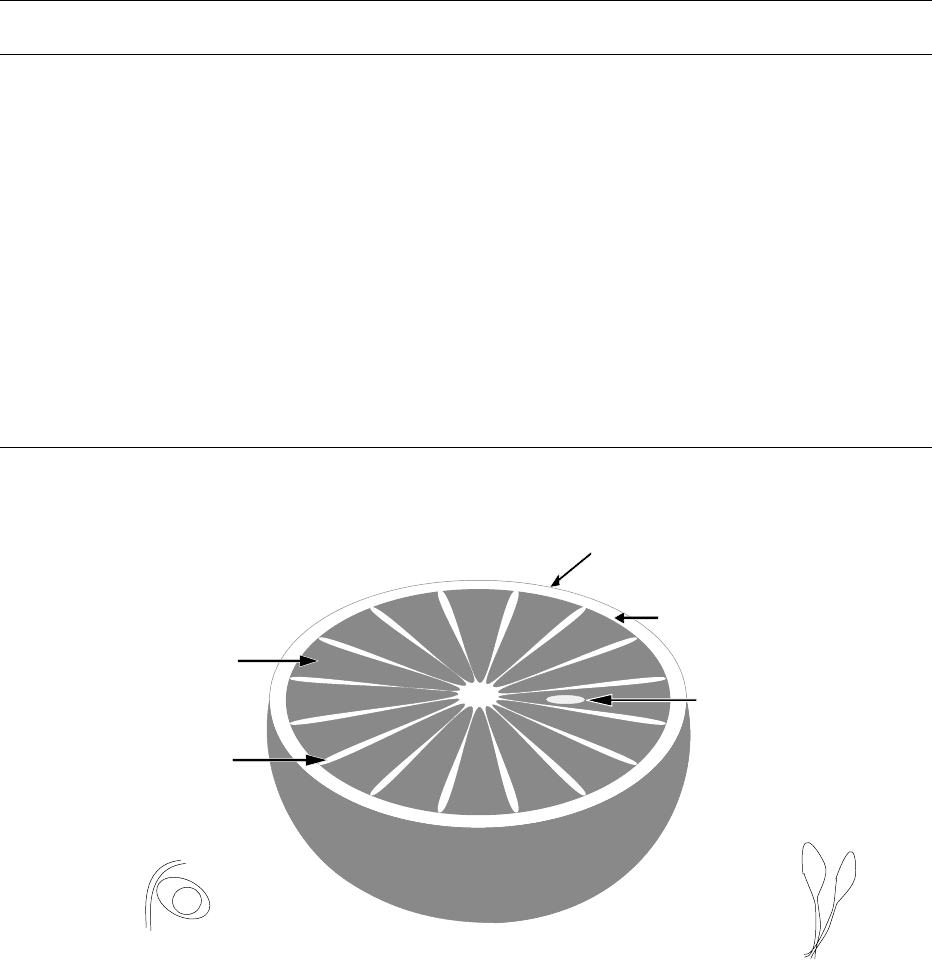
tics of freshness, juiciness, crispness and sugar/acid
content.
0005 To extend the availability of orange fruit during the
year and utilize better processing equipment, varieties
with different ripening periods are grown. Together,
Brazil and the USA grow 50% of the world’s oranges
and produce around 90% of the world’s orange juice.
Some Mediterranean regions, such as Italy, are
oriented to the fresh fruit market, because of more
profit. Italian orange production, concentrated
primarily in the south of Italy, comprises 70% of
pigmented orange (‘Tarocco,’‘Sanguinello,’ and
‘Moro’), and the remainder blonde (‘Navel’ and
‘Valencia late’).
0006Blonde oranges contain relatively large amounts of
a mixture of carotenoids, whereas the red color of
blood oranges is due to (besides carotenoids) antho-
cyanins, water-soluble pigments such as cyanidin-
3-glucoside and delphinidin-3-glucoside in Moro
oranges. Many of the biological properties of these
compounds have been correlated with their ability
to scavenge oxygen-generated free radicals and to
tbl0001 Table 1 Quality parameters of orange juices
Brix Min 10.0 Potassium 1300–2500 mg l
1
Density Min 1.040 Magnesium 70–160 mg l
1
L-Ascorbic acid Min 200 mg l
1
Titratable acid 90–240 meq
Volatile acids Max 0.4 g l
1
Citric acid 6.3–17.0 g l
1
Volatile oils Max 0.3 mg l
1
L-malic acid 0.8–3.0 g l
1
Ethanol Max 0.3 g l
1
Calcium 60–150 mg l
1
Lactic acid Max 0.5 g l
1
Phosphorus 115–210 mg l
1
D-Malic acid Absent Nitrates Max 10 mg l
1
Sulfurous acid Absent Sulfates Max 150 mg l
1
Hydroxy methyl furfurol Max 20 mg l
1
Formol index 15–26
Arsenic Max 0.1 mg l
1
Esperidin Max 1000 mg l
1
Lead Max 0.2 mg l
1
Total pectin Max 700 mg l
1
Copper 5.0 mg l
1
Soluble pectin Max 500 mg l
1
Zinc 5.0 mg l
1
Carotenoids Max 15 mg l
1
Iron 5.0 mg l
1
Glucose 20–50 g l
1
Tin 1.0 mg l
1
Fructose 20–50 g l
1
Mercury 0.01 mg l
1
Saccharose 10–50 g l
1
Cadmium 0.02 mg l
1
Ethanolamine Max 36.6 mg l
1
Sodium Max 30 mg l
1
Ammonium Max 25.5 mg l
1
Source: Association of the Industry of Juices and Nectars from Fruits and Vegetables of the EEC (24/1/1996).
Flavedo
essential oil, carotenoids a/o anthocyanins
Albedo
flavonoids, cellulose,
pectins, amino acids
Seed
lipids, proteins,
mineral salts
Pulp
vitamins, amino acids, oxiacids,
carotenoids a/o anthocyanins
sugars
Membrane
flavonoids, pectins, sugars,
cellulose
Oil gland
Juice sacs
fig0001 Figure 1 Transverse section of orange fruit with constituents and enlarged views of juice sacs and oil gland.
CITRUS FRUITS/Processed and Derived Products of Oranges 1347
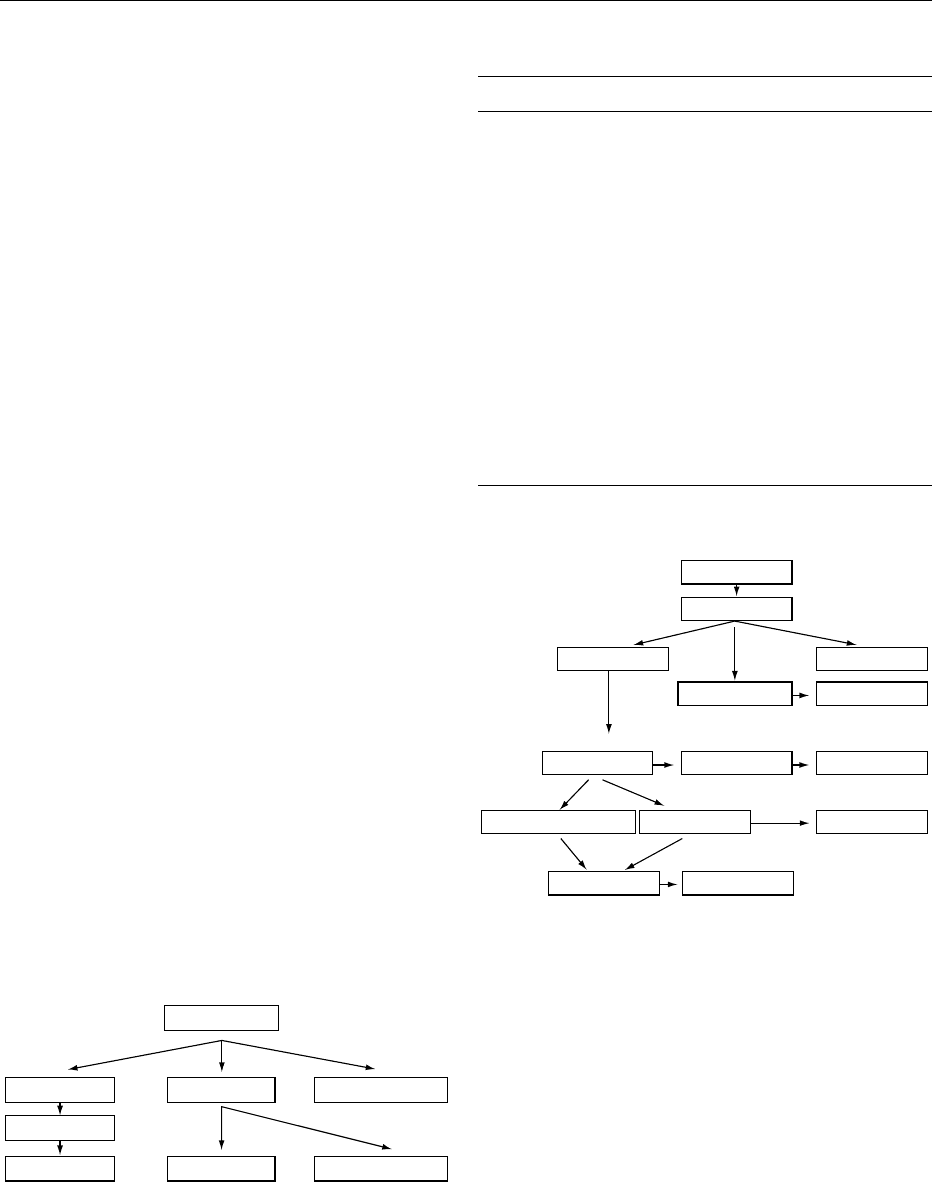
inhibit lipid peroxidation. With regard to therapeutic
properties, anthocyanins are largely used in the
pharmaceutical industry because of their ability
to prevent capillary fragility. The most important
objective at the moment in Italy is the qualitative
improvement of pigmented oranges and their juice,
which has created a niche market for export in North-
ern Europe (Denmark, Germany, Holland, Sweden,
Switzerland) (Figure 2).
Juice
0007 Orange juice, the predominant product of the citrus
industry, has the sensory and nutritional properties
of the fresh fruit (Table 2), but, being a complex
beverage sensitive to treatments, it is very difficult to
preserve the same level of quality of orange juice
squeezed directly from fresh oranges. The maximum
juice yield from an orange is 40–60% by weight,
depending on the fruit variety and local climate.
0008 Even if orange fruit is not climacteric, its quality
begins to deteriorate after picking, and so it must be
processed into juice and other products as quickly as
possible to insure that the microbiological, nutritional
and sensorial qualities are maintained (Figure 3).
0009 Oranges unloaded by hydraulic lifts from storage
silos on the waiting conveyors undergo a first wash-
ing to remove dirt, leaves, and stems, and then, in the
first grading process, damaged or substandard fruit is
removed. The oranges are then conveyed to the final
washing and grading area, where they are inspected
and automatically sorted by size for entry to the
extractor.
0010 Two extraction systems are used: (1) squeezing and
(2) reaming, either whole or halved, under mechan-
ical pressure. In the first system as shown in Figure 4
the fruit are often lined up (up to 15 per line). The
cups (upper and lower) are brought together as the
corresponding cutters cut two holes in the fruit (Step
1). As the cups continue to come together, the peel
is separated from the fruit, which is forced into the
prefinisher tube (Step 2). The peeled fruit moves into
the orifice tube through the holes of the prefinisher
tube, forcing the juice to flow into the manifold (Step
3). The juice is instantaneously separated from the
seeds, and the rest of the fruit, including the oil emul-
sion, is sent to the centrifugal processing part.
0011In the reamer type of extractor, the fruit is cut in
half, and the halves are penetrated and rotated by a
series of nylon reamers mounted on a rotating turn-
table. The juice, pulp, rag, and seeds are separated
from the peel by a strainer, and the juice and pulp are
separated from the rag and seeds and passed to the
Frozen
Defrosted
DefrostedReconstituted
Chilled −20 ⬚C
Freshly squeezed
Heated 70 ⬚C
8 days
2 days 30 days60 days
Juice extracted
fig0002 Figure 2 Orange juices in the European market. Shelf-lives
shown (in days) are applicable to a storage temperature of 4
C.
Source: Maccarone E, Campisi S, Cataldi Lupo MC, Fallico B and
Nicolosi Asmundo C (1996) Effetti dei trattamenti tecnologici sui
costituenti del succo di arancia rossa di Sicilia. Industrie delle
Bevande XXV: 335–341.
tbl0002Table 2 Chemical composition and energy of orange fruit and
orange juice
Orange fruit Orange juice
Edible part (%) 80 100
Water (g) 87.2 89.3
Protein (g) 0.7 0.5
Lipid (g) 0.2 0
Carbohydrate 7.8 8.2
Fiber (g) 1.6
kcal 34 33
kJ 142 138
Sodium (mg) 3 3
Potassium (mg) 200 200
Iron (mg) 0.2 0.2
Calcium (mg) 49 15
Phosphorus 22 17
Thiamin (mg) 0.06 0.05
Riboflavin (mg) 0.05 0.03
Niacin (mg) 0.2 0.4
Vitamin A retinol equivalents (mg) 71 38
Vitamin C (mg) 50 44
Source: National Institute of Nutrition, Rome.
Fruit
Extraction
Pulpy juice
Clarification Pulp Pulp wash
EssenceConcentrate
DistributionPackaging
Not from concentrate
Peel oil
Feed millPeel, rag, seed
fig0003Figure 3 Flow chart of orange processing.
1348 CITRUS FRUITS/Processed and Derived Products of Oranges
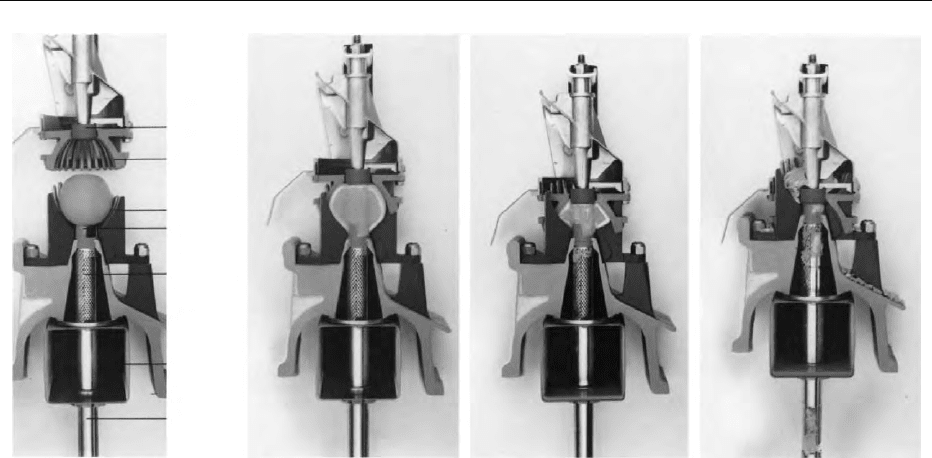
finishers. In this system, peel oil can be recovered in a
separate step by puncturing the oil sacs of the flavedo
and washing the oil out.
0012 Another extraction system is the rotary press,
popular in the Mediterranean area since the turn of
the twentieth century. This machine consists of a
combination of two units arranged in a cascade, one
to extract essential oil by rasping the outer surface of
the whole fruits and the other to extract juice. Fruits
introduced into the machine are pushed forward by
paddles along couples of rotating rasping cylinders.
The essential oil is then gathered by sprays of water,
the mixture flows into a finisher to eliminate any solid
particles, and essential oil is recovered by centrifugal
separators. After oil extraction, the fruits are cut into
two halves and squeezed against a stainless steel
screen, and then seeds, pulp, and peels are removed
from the juice. Juice obtained by the different ex-
traction processes has a high content of pulp derived
from juice vesicles and membrane material. These
represent the principal part of the segments, which,
during processing, are destroyed by enzymes and
microorganisms in the peel. Lactobacillus and Leu-
conostoc are the most common genera of lactic acid
bacteria that cause spoilage of orange juice, pro-
ducing diacetyl and, consequently, off-flavors. The
yeasts Saccharomyces cerevisiae, Rhodotorula, and
Zygosaccharomyces can impart a fermented taste,
transforming the delicate aroma of orange juice into
an unpleasant smell. Only rarely are molds respon-
sible for juice spoilage, because, even if they grow in
juice, they are generally sensitive to heat treatment.
(See Yeasts.)
0013The pulpy juice therefore must be finished and
clarified by centrifugation to remove the oil, if neces-
sary, before undergoing further treatments. A recent
improvement of clarification has been introduced,
using ultrafiltration to separate the serum from the
pulp. The latter is then subjected to thermal treatment
before being remixed with the serum to obtain a
product with a better flavor and nutritional value.
After this step, the juice takes different paths, leading
to different products:
.
0014Freshly squeezed juice: This has a shelf-life of 5–6-
day and is a product that is not thermally pro-
cessed, thus satisfying increasing demands for
natural products. The raw materials are selected
with great care, and washed, squeezed, aseptically
packaged, and distributed for retail.
.
0015Not-from-concentrate juice: Minimal thermal
treatment is used for this juice. It is processed and
stored frozen, or quickly pasteurized and stored
in aseptic form. Most of these juices also consist
of a blend, differing in quality in terms of color,
sugar content, etc., being extracted throughout
the picking season and/or in different producing
countries.
.
0016Frozen concentrate orange juice: This form is very
advantageous for storage and freight, requiring
less than five to six times volume than fresh juice.
It provides a year-round supply to consumers
and consists of a concentrate of a blend of specified
quality from different orange varieties. Analytical
control of blends uses the following characteristics:
Brix, per cent acid, Brix/acid ratio, per cent oil, per
Upper cutter
Upper cup
Lower cup
Lower cutter
Prefinisher
tube
Juice
manifold
Orifice tube
Step 1 Step 2 Step 3
fig0004 Figure 4 (see color plate 29) FMC juice extractor principle. Courtesy of FMC Food Tech Citrus System, Catania (Sicily) Italy.
CITRUS FRUITS/Processed and Derived Products of Oranges 1349
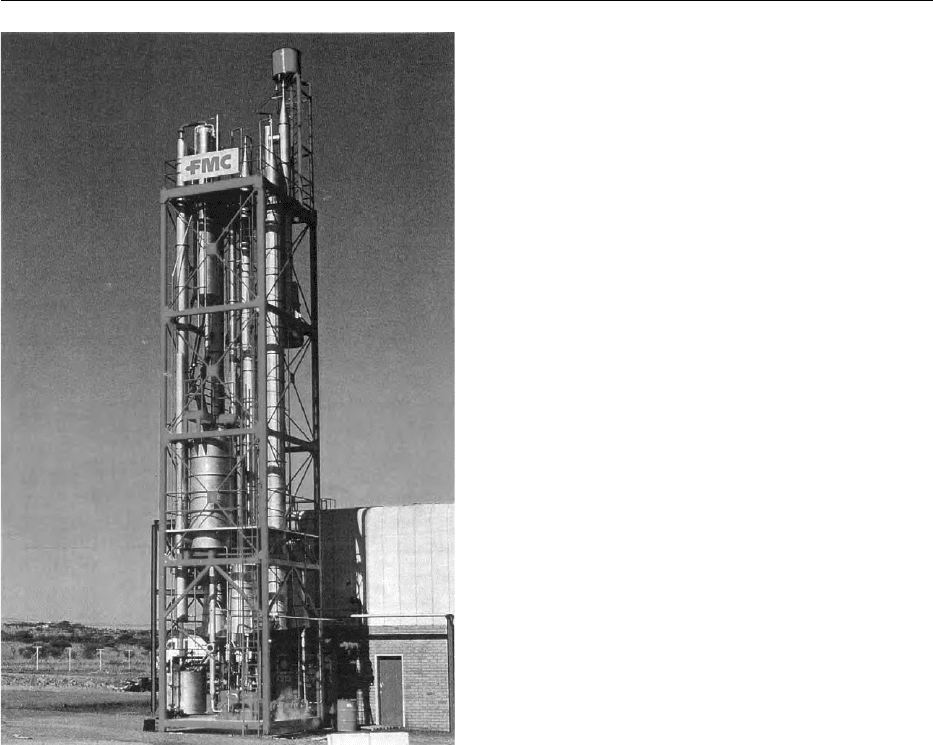
cent pulp and color. Today, a ‘thermally accelerated
short-time evaporator’ is often used (Figure 5),
which yields a concentration of up to 65/75
Brix
in a very short time, thus insuring a high product
quality. (See Heat Treatment: Chemical and Micro-
biological Changes.)
During a preheating cycle, juice is pasteurized to
deactive pectinase enzymes (which cause cloudiness)
and prevent spoilage, thus prolonging the shelf-life. It
then undergoes a variable number of stages under
vacuum until the required concentration is obtained.
The disadvantage is that the heat treatment reduces
the oxidative balance and removes some of the flavor
components. Particularly in blood-orange juice, a
considerable change in color is ascribed to the deg-
radation of anthocyanins and the different distribu-
tion of carotenoids between the serum and pulp
structure in juices reconstituted from concentrate.
There is also a remarkable loss of aroma components
and generation of off-flavors such as p-vinylguaiacol,
p-vinylphenol, and decarboxylation products of
hydroxycinnamic acids in red juices processed and
stored for up to 4 months.
Byproducts
0017The use of whole fruit in citrus processing is necessary
to reduce costs and justify new investments in equip-
ment, providing a correct solution for the pollution
problem connected with the process. Any improve-
ment in the recovery process would be of great inter-
est, especially if this were obtained using technologies
respectful of product quality such as the use of
enzymes, peeling of the fruit, reduction of bitterness
juices, reduction in the viscosity of pulp wash, and
hydrolysis of peel solids to produce fermentable
sugars.
Comminuted juice
0018Originally developed in the UK, this byproduct is
made by milling the whole fresh fruit or by mixing
juice concentrate with milled peel. The comminuted
citrus base has a stronger flavor and provides more
cloud than pure orange juice, thus imparting a good
orange flavor in fruit drinks of low fruit content.
Peel Oil
0019Valuable oil recovered (about 0.3% of the fruit
intake) from peel is used to produce various flavor
compounds in the beverage, chemical and cosmetic
industries. ‘Cold-pressed peel oil’ is obtained by
mechanical pressure of oil glands (using different
methods), whereas a less valuable oil can be re-
covered by distillation of waste peel residue. Among
the numerous compounds, the major component is
d-limonene, which is also used in the electronics
industry and in the manufacture of synthetic resins
and adhesives. Other hydrocarbons produced include
myrcene, a-pinene, sabinene, and valencene. Import-
ant aromatic compounds include aldehydes, esters,
alcohols, ketones, and phenols, and the nonvolatile
residues include waxes, coumarins, flavonoids, fatty
acids, and sterols. To avoid the problem of dissolved
wax from peel, the oil is stored at 1
C (winterization)
to allow successive sedimentation of wax.
0020Colored essential oils rich in carotenoids can be
obtained from orange peels, for use as colorants in
the drink industry. The increased use of citrus essen-
tial oil to aromatize baking products promotes the
technology of encapsulation by drying spray obtaining
powders capable of maintaining the aroma intensity
during cooking. Another interesting technology is the
extraction of essential oil using supercritical fluid,
fig0005 Figure 5 (see color plate 31) Model thermally accelerated
short-time evaporator. Courtesy of FMC Food Tech Citrus
System, Catania (Sicily) Italy.
1350 CITRUS FRUITS/Processed and Derived Products of Oranges

especially CO
2
. Among the citrus peels, the most
important essential oil is extracted from bergamot
(C. bergamia, Risso) hybrid, a close relative of the
sour orange cultivated only in the narrow strip of land
of Southern Italy (Calabria). It is indispensable to the
international perfume industry and is also used in the
pharmaceutical industry as an antiseptic and as an
aroma for liqueurs, tea, sweets, and candied fruits.
Essence
0021 The recovery of volatile components (essence) from
the evaporation process constitutes an interesting use
of this component. Two phases are separated: the first
containing the water-soluble compounds (essence
aroma) and the second (essence oil), containing fruit
flavor. The latter is more desirable than peel deriva-
tives in the manufacture of flavor mixtures for the
beverage and other food industries.
Hesperidin
0022 In sweet orange, the predominant flavonoid is the
tasteless and odorless hesperidin, located in the mem-
brane and peel, which is not soluble in neutral solu-
tions but slightly soluble in acidic solution as citrus
juice. After extraction of the juice, the hesperidin
forms crystals that appear as white flakes; these are
more evident during evaporation and concentration
of juice. The recovery of this product is a profitable
investment for its therapeutic properties in the treat-
ment of capillary fragility. The traditional extraction
method, with a very low recovery, treats triturated
peel with alkaline compounds to dissolve the flavo-
noids, which, after separation of solid residue, are
precipitated by acidification. An innovative method
to recover hesperidin from orange peel and waste
water utilizes (at a pH of around 7) styrene-divinyl-
benzene as the absorbing phase and removing the
flavonoid with alcoholic NaOH. The results may be
a useful starting point for industrial applications.
Pectin
0023 Pectin is a product found mainly in the albedo and
juice sac, and has a high molecular weight (100 000–
200 000 Da). Very important for the stability of juice
cloud, pectin consists of long chains of polygalacturo-
nic acid units linked together by a (1–4) glycosidic
bonds with side chains of rhamnose, arabinans, galac-
tans, and xylose. Many of the carboxyl groups are
esterified with methanol to form methoxy groups;
these determine the gelling ability of the pectin used
in jam, marmalade, jelly, and preserve production.
Lemon peel is the most common source for extraction
of commercial pectin. After oil extraction, the peel is
shredded and washed with water to remove sugars
and other soluble material. The peel is heated to
deactivate the pectinase enzymes and then treated
with hot mineral acid to extract pectin. To the con-
centrated solution (containing a low content of
pectin) alcohol is then added to 50–70% by weight,
resulting in a precipitate of pectin in a gelatinous
mass, which can be washed and dried as a powder.
(See Pectin: Food Use.)
Peel in Brine and Candies
0024The peel in this case must be processed by a soft
system, as ‘sfumatura,’ or peeling to extract the oil.
First, the peel is hardened using lime, dried, and
dipped for 24 h in tanks containing 3% sodium chlor-
ide. Then, the peel is dripped, stored in containers,
and transferred to candy factories. Immersion in hot
water for a few minutes softens the peel. The peel is
cut by machine to undergo a cold or warm liquid
sweetening process, depending on the technology
chosen. The former process requires more time, be-
cause the diffusion of sugar into peel is slow, but the
sensory characteristics of these candies are more valu-
able than those obtained by the latter process.
Fruit Sections
0025Very popular in the USA and Israel, fruit sections have
good nutritional characteristics and a long shelf-life.
Prior to processing, orange should be held in storage
bins to allow the fruit to soften. Hot-water treatment
at 100
C for a few minutes facilitates peeling by hand
or machine. The fruit is then subjected to a hot caustic
spray (about 2.0% NaOH) for a few seconds and
water sprays to remove the basic solutions. The peeled
fruit is then chilled in water to facilitate sectioning of
the fruit. A sweetener solution containing water, juice,
and sugar is finally added to the fruit sections.
Pulp
0026Pulp recovered after the extraction process usually
can be added back to juice and juice drinks to im-
prove the mouth feel and give a natural appearance
to the product. After the different components are
separated by an in-line extractor, it is possible to
recover whole juice sacs (premium pulp) by the pre-
mium pulp recovery system (Figure 6) (FMC Food
Tech Citrus System).
0027Specially designed extractor components separate
the juice, pulp, core, and seeds into a single stream.
The core material is gently separated from the seeds,
juice, and pulp and sent to the core wash system or
CITRUS FRUITS/Processed and Derived Products of Oranges 1351
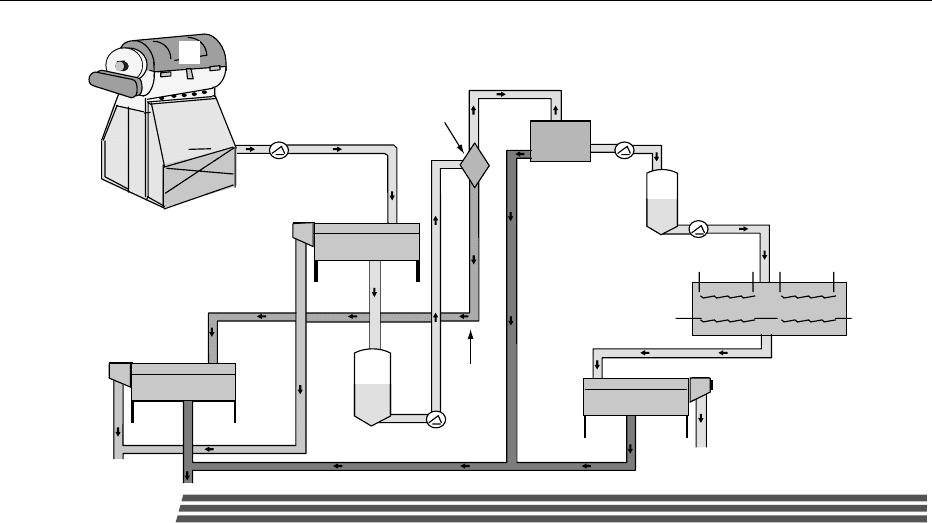
waste. The core stream is finished to separate and
recover any remaining juice. The remaining juice,
seeds, and pulp are sent to a classifying finisher,
which separates the seeds from the pulpy juice stream.
Minor impurities are then removed, and the premium
pulp, finally separated from the juice, is ready for
pasteurization and packaging.
Pulp Wash
0028 Product referred to as ‘water-extracted soluble
orange solids’ is reclaimed from the pulp stream and
is often used in fruit drinks as a source of sugars. It is
also added, where the law permits, as a clouding
agent to provide body and mouth feel because of its
pectin content. The diffusion techniques currently in
use for the preparation of pulp wash are optimized
using a citrus finisher (Figure 7).
0029 The unfinished juice feeds into the finishing cavity,
a space created by a spiral with specially designed
flights inside 360
cylindrical screens, resulting in a
finishing action. Once inside the finisher cavity, the
product is immediately carried outward on to
the screw’s helical spirals, thus making full use of
the entire screen area, which results in high-capacity
finishing. As the screw rotates, air restriction at the
discharge end places pressure on the product causing
the liquid to move toward the lower-pressure area
outside the screen. Once through the screens, the
liquid flows into a fully enclosed pan and discharges.
The pulp discharges through the plug valve assembly.
Animal Feed
0030Unprocessed citrus peel, rag, pulp, and seed consti-
tute waste products, but they can provide substantial
profits if they are processed as feed. As the product is
susceptible to spoilage (owing to its 78–90% mois-
ture content), it must be consumed quickly and pre-
sents expensive transportation costs. The principal
qualitative parameters are the amounts of protein,
crude fiber, fat, ash, and nitrogen-free extract, pri-
marily carbohydrates, which varies somewhat. The
total quality of the feed is generally estimated from
the total digestible nutrients: nitrogen-free extract,
protein, crude fiber, and fat. The type of animal, effect
of these products on food, economics involved, and
storage capabilities must all be considered before
using these waste products.
0031The high acidity of orange peel requires blending
with lemon peel, usually by ensilage with straw and/
or other material. Research carried out in 1960
showed, in mixtures of orange pulp and straw (10%)
ensiled for 2 months, good fermentation and digest-
ibility characteristics without any effluent being
released.
Pressed Peel
0032To reduce transportation costs, the peel is limed, shred-
ded, and pressed to improve the texture and compos-
ition. The reaction between lime and peel removes (by
pressing) about 10% of the peel moisture. After this
Juice, pulp
and defects
Defects
removal
systeml
Juice
Pasteurizer Chiller
Juice and pulp
Pulp and juice
Pump
Defects
Classifier
finisher
Packaging
finisher
Extractor
Juice recovery Juice
Primary
finisher
Pulp to packaging
Pulp and defects to
'pulpwash' or wastet
Pump
Pump
Pump
Concentrator
FMC
fig0006 Figure 6 (see color plate 30) Premium pulp recovery process. Courtesy of FMC Food Tech Citrus System, Catania (Sicily) Italy.
1352 CITRUS FRUITS/Processed and Derived Products of Oranges
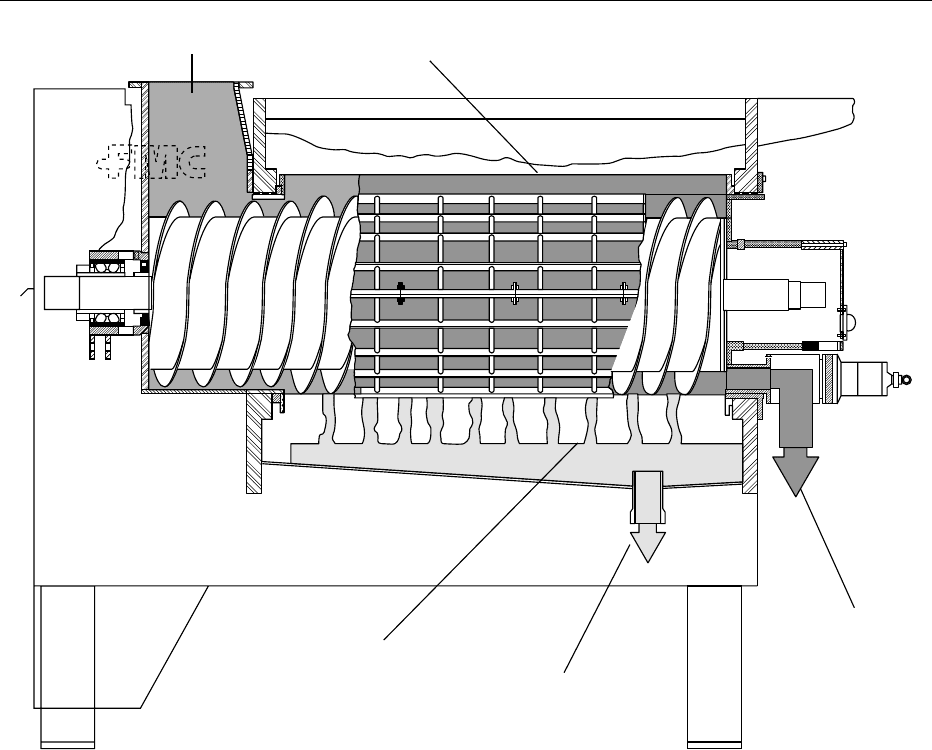
treatment, the peel is shredded and then conveyed to
the peel press. Warm molasses is added to the peel
(1:3), along with some press liquor, and the slurry is
pumped to the feed mill (‘pumped peel’). Using a
supercharger and a sealed screw air pockets are re-
moved, thus allowing the peel to feed into the press
under pressure and to leave the press at a moisture
content as low as 60%.
Dried Peel and Pulp
0033 Dried citrus peel is one of the most common feeds. It
is manufactured by pressing peel through a rotary
dryer and adding citrus molasses to help the drying
process and help prevent the peel from burning. The
moisture content of dried peel must be below 10%.
Many experiments published in the 1970s have
shown that dried orange pulp, partially or completely
replacing cereals in concentrate mixtures, are particu-
larly useful in reducing feeding costs in dairy cows,
have no influence on production, and have a good
palatability. Dried pulp has also been used in swine,
which have been shown to utilize it at a ratio of up to
20–25%. Besides its use as a substitute for maize, up
to 20% in diet has no influence on the growth and
production of laying hens. The dried pulp can be
pelletized and is consumed more easily by ruminants
with advantages of storage, shipping, and microbial
spoilage. Pellets made from dried pulp have different
dimensions, and several factors affect their character-
istics, such as the energy used in pelletizing and the
proportions of citrus molasses (about 5–15% of the
total weight gives excellent results) used as binding
agents.
Citric Molasses
0034The solution obtained from shredded and limed peel
(press liquor) containing 10% sugar is principally
concentrated to citric molasses. It is used as an addi-
tive to animal feed and for the production of citrus
alcohol by fermentation, and also can be mixed with
Finished juice
Product discharge
Pulp discharge
Unfinished juice Pulp
fig0007 Figure 7 Citrus finisher. Courtesy of FMC Food Tech Citrus System, Catania (Sicily) Italy.
CITRUS FRUITS/Processed and Derived Products of Oranges 1353

pressed peel to facilitate drying. In the manufacture of
citric molasses, antifoaming agents are used, or the
suspended solids are removed by centrifugation, to
prevent foaming from microbial spoilage and alkaline
processing. The advantages of citric molasses in terms
of press liquor are a reduction in cost during storage
and a better microbial protection owing to the sugar
content.
Alcohol Production
0035 Citrus press liquor and citric molasses can be used as a
feedstock for commercial alcoholic fermentations
carried out by yeasts in continuous fermentators. The
presence of peel oil, which is toxic to most microorgan-
isms, must be at levels of no more than 0.08%. Press
liquor contains at least 0.2% oil (based on 11.8
Brix),
whereas citric molasses usually contain much less oil
stripped out during evaporation. Liquor is removed
from the citrus press before fermentation, often using
direct steam injection. Also, the oil removed in this
way (steam-distilled oil) can be sold as a fuel, herbi-
cide, or feedstock in chemical manufacture.
Final Consideration
0036 In industrialized countries, the citrus industry cannot
be static, but must apply scientific and technological
know-how to increase the value added to the market
prices of products. It is necessary to develop new mild
technology to limit the damage during processing,
to re-evaluate minor products, and to obtain a new
ingredient better suited to consumer requirements:
fresher products that retain their nutritional charac-
teristics, especially the active components (vitamins,
antioxidants, fermentation agents), have a longer
shelf-life, and are more convenient for ecologically
compatible cultivation and animal rearing systems.
See also: Citrus Fruits: Types on the Market; Composition
and Characterization; Oranges
Further Reading
AIJN (1996) Code of Practice for Evaluation of Fruit and
Vegetable Juices. Brussels: Association of the Industry of
Juices and Nectars of the Economic Community.
Arena E, Fallico B and Maccarone E (2000) Influence
of carotenoids and pulps on the color modification
of blood orange juice. Journal of Food Science 65:
458–460.
Fallico B, Lanza CM, Maccarone E, Nicolosi Asmundo C
and Rapisarda P (1996) Role of hydroxycinnamic acids
and vinylphenols in the flavour alteration of blood
orange juices. Journal of Agricultural and Food Chemis-
try 44: 2654–2657.
Fox K (2000) New technology in citrus processing. Fruit
Processing 10: 94–101.
Kimball DA (1999) Citrus Processing: A Complete Guide,
2nd edn. Gaithersburg, MD: Aspen.
Maccarone E, Campisi S, Cataldi Lupo MC, Fallico B and
Nicolosi Asmundo C (1996) Effetti dei trattamenti
tecnologici sui costituenti del succo di arancia rossa
di Sicilia. Industrie delle Bevande XXV: 335–341.
Manthey JA and Grohmann K (1996) Concentrations of
hesperidin and other orange peel flavonoids in citrus
processing byproducts. Journal of Agricultural and
Food Chemistry 44: 811–814.
Parish ME (1991) Microbiological concerns in citrus juice
processing. Food Technology 4: 128–133.
Redd JB and Hendrix CM (1993) Processing of natural
citrus oils and flavors. In: Nogy S et al. Fruit Juice
Processing Technology. Auburndale FL: Agscience.
Rouseff RL and Nagy S (1994) Health and nutritional
benefits of citrus fruit components. Food Technology
48: 125–126, 128–129, 132.
Tetra Pak Processing Systems (1998) The Orange Book.
Lund: Tetra Pak.
Wang H, Cao G and Prio L (1997) Oxygen radical
absorbing capacity of anthocyanins. Journal of Agricul-
tural and Food Chemistry 45: 304–309.
Lemons
R Goodrich, University of Florida, Lake Alfred, FL, USA
Copyright 2003, Elsevier Science Ltd. All Rights Reserved.
Background
0001Lemon (Citrus limon (L.) Burm.) a yellow or pale
yellow prolate fruit with five to 10 seeds, botanically
a berry, is known throughout the world, and is used in
numerous foodways and cuisines. The juice of the
fruit is commonly used as a food ingredient in both
commercial and home recipes, and is valued for its
tart, tangy, and fresh character. The exceptionally
fragrant rind is used as a garnish and flavoring and is
a major source of commercial essential oil and aroma
compounds. The lemon flower is sweetly scented,
with an aroma similar to other citrus flowers. The
essential oils from the flowers, twigs, and fruit can be
distilled or otherwise extracted to obtain materials
suitable for use in flavors and fragrances.
0002The lemon tree is a small, thorny tree that grows
well throughout the tropical and subtropical regions
of the world. Lemons are cultivated in modest
amounts for home use almost everywhere that citrus
trees can survive, but large-scale commercial produc-
tion is limited to the subtropical regions since more
humid tropical environments enhance pest and
1354 CITRUS FRUITS/Lemons

disease problems for both fruit and tree. Lemon trees
grow to about 3–6 m and are sparsely foliaged. Com-
pared to orange and grapefruit, the trees are rather
cold-sensitive. Because of the lemon’s lower sugar
content, the fruit can freeze at temperatures that
would not affect other citrus.
000 3 The lemons has existed for so long that its true
origin is not known, although experts believe it was
probably a hybrid of the citron (C. medica). The first
recorded habitat of the lemon was South-east Asia
(Myanmar, and southern China); from there, it was
introduced to Persia and the Middle East, were it
was well established by the twelfth century. Around
1150, Arabs took the lemon to Spain and North
Africa. The lemon traveled from the Mediterranean
to the New World with Columbus on his second
voyage in 1493. Lemon culture spread from Haiti
through the West Indies and then to South and
North America. Plantings existed in Florida by the
1500s and were established in the mission gardens of
California and Baja California by the mid-eighteenth
century.
Worldwide Production
0004 Leading producers are Argentina, Spain, California
(USA), and Italy. Table 1 summarizes lemon fruit
production for the 1995–96 and 1999–2000 seasons.
Production from the top four countries accounted for
about 75% of the world’s total output. Argentina and
Spain in particular have experienced significant
growth in lemon production in the past few decades;
in 1965, the USA and Italy alone accounted for about
75% of the world’s lemons. From a global perspec-
tive, understanding the system of coordination of
production, harvesting, and marketing of lemon
fruit is complicated due to factors such as multiple
harvesting seasons, the numerous commercial var-
ieties, and the substantial regional differences in
practices and markets throughout the world. The
following discussion summarizes the commercially
important lemon varieties and harvesting periods in
the major lemon producing regions.
000 5 The principle varieties of lemon are listed in
Table 2, along with their associated growing regions.
Different varieties of lemons can be difficult to iden-
tify by the fruit alone, especially as the everbearing
trait results in the presence of fruits of various size,
color, and appearance on a single tree at the same
time. Most lemon fruits are oval to elliptical in
shape, with characteristic necks (stem end) and
nipples (blossom end). The peel is yellow at maturity
(generally) but can vary substantially in thickness and
smoothness. The flesh is pale yellow (straw-colored)
and very acidic, and can have a variable number of
seeds. As a further complication, the same variety can
present visually different fruit under different climate
conditions and horticultural practices. Lemons are
often identified by tree characteristics, which are less
variable.
0006Most of the US production is from California, al-
though there is some from Arizona. In coastal Cali-
fornia, the primary growing region, the lemon tree
blooms and sets fruit essentially year round, but there
is a heavier set in the spring and fall season. This
multiple flowering and fruiting phenomenon can
be utilized to provide a steady stream of fruit with
pickings occurring every 6–8 weeks throughout the
year. In south-central California and Arizona, the
other major lemon-producing areas in the USA, har-
vesting is usually limited to late fall to early winter
(October through January).
0007One of the oldest commercial varieties is the
Eureka lemon, and it is also one of the most widely
grown varieties outside the Mediterranean area. It is a
major part of the crop in California, Australia, South
Africa, and Israel. It is also a significant part of
Argentina’s crop. The Eureka has achieved predomin-
ance due to its quality and productivity, and because a
large proportion of fruit matures during late spring
and summer when demand and prices are greatest.
New plantings of the Lisbon lemon have replaced
Eureka in central California due to the former’s
dense foliage, making the fruit less susceptible to
tbl0002Table 2 Leading lemon (Citrus limon) varieties
Variety Primarygrowinglocation(s)
Bearss (Sicilian) Florida (USA)
Eureka California (USA), Australia,
Argentina, Israel
Lamas Turkey (early season)
Lisbon California, Arizona (USA), Australia
Meyer Lemon
(not a true lemon)
USA, New Zealand
Verna (Berna) Spain
tbl0001Table 1 Lemon production (tonnes) by selected countries for
crop years 1995–96 and 1999–2000
1995^96 1999^2000
Argentina 720 1050
Spain 457 899
USA 900 797
Italy 699 590
Turkey 418 500
Greece 133 155
South Africa 71 110
FromUSDA,ForeignAgriculturalServiceswww.fas.usda.gov.
CITRUS FRUITS/Lemons 1355
